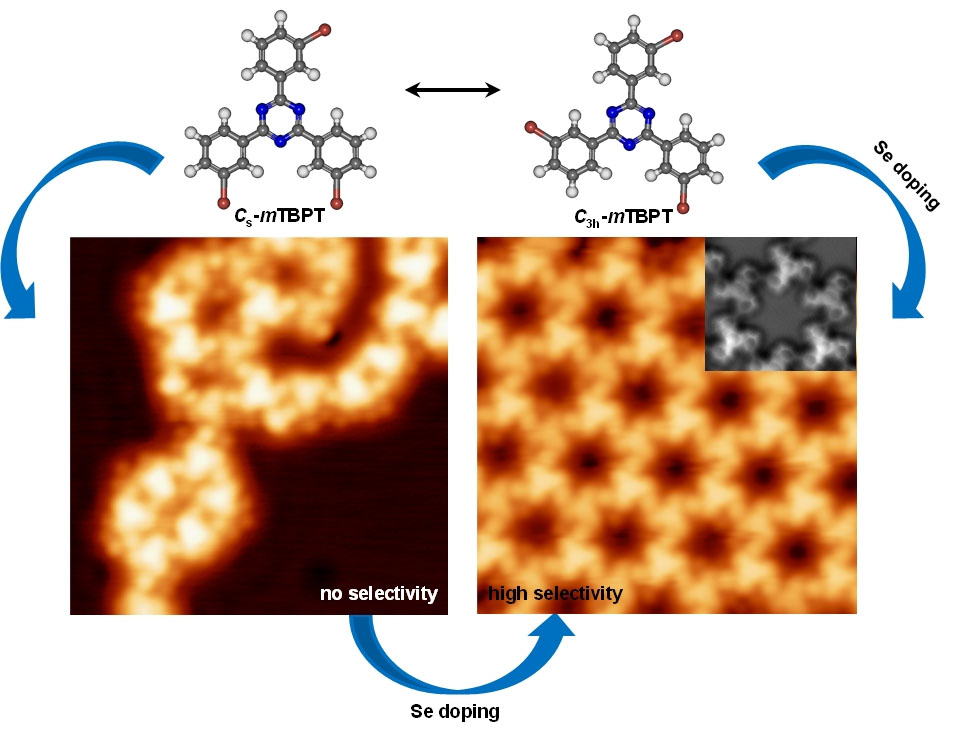| Sep 16, 2024 |
Controlling molecular arrangements using selenium doping
(Nanowerk News) Physicists from the National University of Singapore (NUS) have achieved controlled conformational arrangements in nanostructures using a flexible precursor and selenium doping, enhancing material properties and structural homogeneity. Their method advances on-surface synthesis for the design and development of engineered nanomaterials.
|
|
On-surface synthesis has been extensively investigated over the past decades for its ability to create diverse nanostructures. Various complex nanostructures have been achieved through the smart design of precursors, choice of substrates and precise control of experimental parameters such as molecular concentration, electrical stimulation and thermal treatment.
|
|
Among these methods, the Ullmann coupling is notable for efficiently linking precursors through dehalogenation and covalent bonding. While most research has focused on conformationally rigid precursors, exploring conformationally flexible precursors offers significant potential for developing complex functional nanomaterials with engineered structures and properties.
|
|
A recent study led by Professor Andrew WEE from the Department of Physics at NUS demonstrated topology selectivity in a conformationally flexible precursor, mTBPT using selenium (Se) doping. The precursor features a triazine ring with three meta-bromophenyl groups and exhibits conformers with C3h and Cs symmetries. Conformers are molecules with the same molecular formula and connectivity of atoms but differ in the spatial arrangement of their atoms due to the rotation around single bonds. Initially, a random mixture of these conformers form upon deposition on the copper (Cu(111)) substrate.
|
 |
| The figure illustrates scanning tunneling microscopy images of the reaction pathway of mTBPT on a Cu(111) substrate, showing the transition from random organometallic structures before selenium doping to well-ordered crystalline two-dimensional metal-organic nanostructures after doping. (Image: Nature Communications)
|
|
By doping with 0.01 monolayer Se at temperatures ranging from room temperature to 365 Kelvin, the researchers achieved high selectivity for the C3h conformer. This significantly improved structural homogeneity and forms an ordered two-dimensional metal-organic framework (MOF). The process remains effective regardless of the deposition sequence of mTBPT and Se.
|
|
The research findings have been published in the scientific journal Nature Communications ("Topology selectivity of a conformationally flexible precursor through selenium doping").
|
|
Dr Liangliang CAI, a research fellow on the team said, “We used a combination of high-resolution scanning tunneling microscopy and spectroscopy with non-contact atomic force microscopy at a low temperature of 4 Kelvin to study the formation of the conformationally flexible precursor mTBPT on a copper substrate and its high topology selectivity using selenium doping.”
|
|
The research team also used density functional theory calculations, both with and without Se, to model the transformation between Cs−Cu and C3h−Cu moieties on the Cu(111) substrate to explain the high topology selectivity of the C3h conformers by Se doping.
|
|
“Understanding the doping effects, especially selenium doping, is important in view of the increased interest in two-dimensional selenides and on-surface synthesis. This insight could lead to the controllable synthesis of tailored metal-organic and covalent organic framework nanostructures in the future,” added Prof Wee.
|

